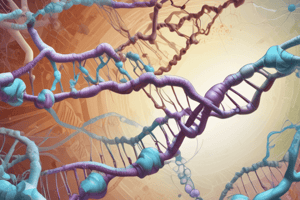Podcast
Questions and Answers
What is the process by which the information in a gene is used to direct the assembly of a protein?
What is the process by which the information in a gene is used to direct the assembly of a protein?
- Translation
- Epigenetic modification
- Transcription
- Gene expression (correct)
What is the function of transfer RNA (tRNA) molecules in gene expression?
What is the function of transfer RNA (tRNA) molecules in gene expression?
- To transcribe DNA into mRNA
- To replicate DNA during cell division
- To synthesize proteins directly from DNA
- To match their anticodon to the mRNA codon and add amino acids (correct)
What is the term for the additional layers of control that allow for a gene expression profile to be passed from a cell to its daughter cells?
What is the term for the additional layers of control that allow for a gene expression profile to be passed from a cell to its daughter cells?
- Genetic transcription
- Epigenomic modifications (correct)
- Gene regulation
- Epigenetic inheritance
What is the result of DNA methylation on gene expression?
What is the result of DNA methylation on gene expression?
How many different amino acids are used to build proteins during translation?
How many different amino acids are used to build proteins during translation?
What is the term for the modification of gene expression that does not change the DNA sequence?
What is the term for the modification of gene expression that does not change the DNA sequence?
What is the term for the full set of chemical modifications in a cell that direct transcription?
What is the term for the full set of chemical modifications in a cell that direct transcription?
What type of cells can form a whole organism, including the embryo and placenta?
What type of cells can form a whole organism, including the embryo and placenta?
What is the process by which one of the two X-chromosomes in females is inactivated?
What is the process by which one of the two X-chromosomes in females is inactivated?
What is the term for a genetic variation that occurs in more than 1% of copies of alleles?
What is the term for a genetic variation that occurs in more than 1% of copies of alleles?
What is the term for the transfer of epigenetic marks from parent to offspring?
What is the term for the transfer of epigenetic marks from parent to offspring?
What is the result of DNA methylation on one of the two X-chromosomes in females?
What is the result of DNA methylation on one of the two X-chromosomes in females?
Study Notes
Gene Expression
- Gene expression is the process by which the information in a gene is used to direct the assembly of a protein.
- Messenger RNA (mRNA) is transcribed from the DNA if the gene is active.
- The sequence of the gene is read in groups of three bases, with each group (codon) corresponding to one of 20 different amino acids used to build the protein.
- Transfer RNA (tRNA) molecules match their “anticodon” to the mRNA codon, and add the corresponding amino acid to the protein during translation.
Regulation of Gene Expression
- Epigenetic modifications allow for a gene expression profile to be passed from a cell to its daughter cells.
- Epigenetic marks do not change the DNA sequence and are referred to as being “above the genome”.
- Epigenetic mechanisms include direct modifications to the DNA (DNA methylation) and modifications to the packaging of DNA (Histone modification).
Epigenome Over Time
- The epigenome is the full set of chemical modifications in a cell that tell the genome what to do, by directing transcription.
- The epigenome is passed on through cell division, helping cells to remain specialized.
- The epigenome can also develop over time, for example during embryonic development.
Totipotent, Pluripotent, and Multipotent Cells
- Totipotent cells can form a whole organism (embryo and placenta), with few epigenetic marks.
- Pluripotent cells can form all layers of the trilaminar embryo but not the placenta, with more epigenetic marks.
- Multipotent cells can form cells within a particular lineage, with more epigenetic marks specific to that lineage.
Differentiated Cells
- Differentiated cells have extensive epigenetic marks specific to that tissue.
- If the cells are still dividing, the epigenetic marks are carried over to daughter cells.
DNA Methylation
- DNA methylation is key to some important cellular events, including genomic imprinting and X-chromosome inactivation.
- In females, X-chromosome inactivation occurs through DNA methylation, resulting in the inactivation of one X-chromosome, which appears as the Barr body.
Genetic Variation
- The reference sequence developed by the Human Genome Project allows for identification of genetic variations.
- Types of variants include single nucleotide variants (SNV) and common variants, which are likely to represent normal variation and are unlikely to be deleterious to the individual.
- Common variants are also referred to as polymorphisms, occurring in >1% of copies of alleles.
Studying That Suits You
Use AI to generate personalized quizzes and flashcards to suit your learning preferences.
Description
Understand the process of gene expression, from transcription to translation, and how messenger RNA, transfer RNA, and codons work together to build proteins.




